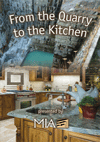Each May, Stone World publishes the year-end summary
of all stone imports into the U.S.,
which are recorded by the U.S. Department of Commerce. For comparative
purposes, we also publish the year-end statistics from a year before. Up to a
few years ago, these summaries were an excellent way to gauge the growth of the
industry - as well as the increased market share of specific stone-producing
nations. This year, however, the report (which can be found on pages 26 to 32
of this issue) is a black-and-white illustration of just how difficult 2009 was
for the stone industry.
Comparing the 2009 stone import figures to 2008, the following “lowlights” can
be found:
• Overall stone imports into the U.S. fell from $2.262 billion to $1.404
billion,
a
decline of 38%
• Granite imports dropped from $1.148 billion to $723.63 million, a decrease of
37%
• Marble imports went from $950.75 million to $568.43 million, a drop of nearly
40%
• Slate imports declined from $101.05 million to $63.11 million, a fall of
38%
Looking at specific nations that export stone to the U.S., Italy seems to have
been hurt the most by the recession - perhaps because they are also the leader
in supplying stone with the most added value. Italian stone suppliers saw their
exports to the U.S.
decline by nearly 50%, going from a total of $373.31 million in 2008 to $190.1
million in 2009. These drop-offs were consistent among all materials - granite,
marble, slate and other stones.
Looking specifically at granite-exporting nations, India was hit particularly hard, as
its granite exports declined to $89.56 million - a drop of 47%. Meanwhile,
although Brazil suffered a
33% decline in its granite exports to the U.S. in 2009, its total value of
$281.79 million still places it as the world leader in this category. The
second leading exporter of granite to the U.S. - China - saw the least decline
among the major players, as it dipped 28% to a total of just under $193
million.
Better times in 2010
Now that all of this ugliness has been laid out in no uncertain terms, all
indicators are that these numbers will all improve over the course of this
year. A number of major distributors have told Stone World that they are in the
process of replenishing their inventories, and they have reported increases in
their imports of containers during the first few months of
2010.
Foreign distributors in markets such as Brazil have reported strong business
over the first quarter of the year, and it is hoped that the official figures
from the U.S. Department of Commerce will bear this out as they are released
over the next few months.
Meanwhile, a number of large-volume stone fabricators have also reported
increased activity in 2010 as remodeling activity slowly rebounds. Some have
also expanded into markets such as healthcare and institutional work, which has
resulted in a number of shops that are busier now than they were a year
ago.
The general consensus is that 2009 was when this lingering recession “hit
bottom” for the stone industry, and we all look forward to the a full recovery
that appears to have already begun.
Leaving 2009 in the rearview mirror

